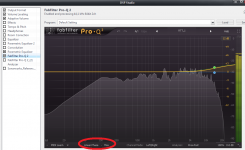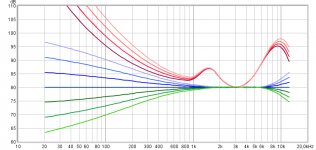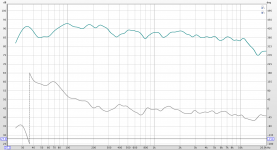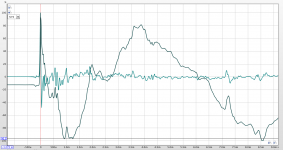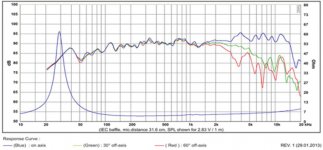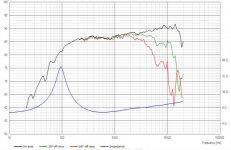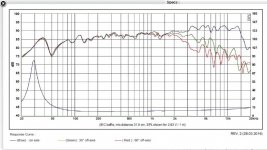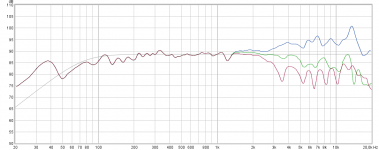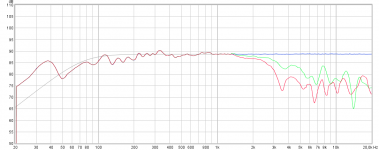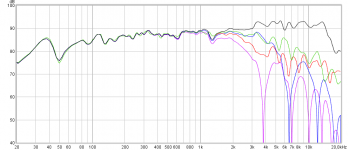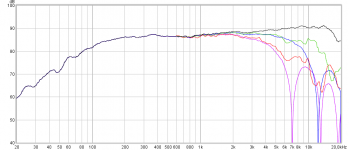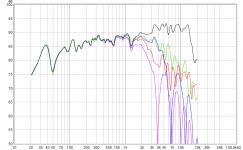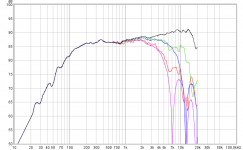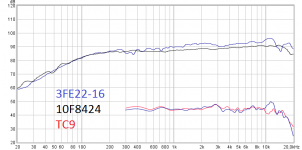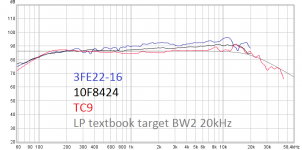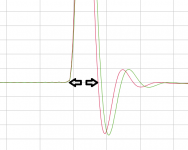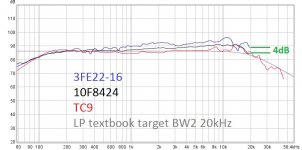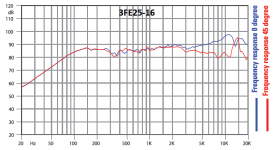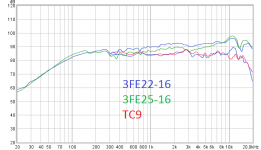In the easiest terms I can find, the sound from a horn seems "shot" at me and to my ears feels unnatural.
The sound from OB irradiates, and is more pleasing to me.
As a disclaimer, I've never heard a Bushmeister style point source horn... I can only extrapolate from previous listenings where horns were involved, mostly Klipsch, so my assumption could be flawed.
The sound from OB irradiates, and is more pleasing to me.
As a disclaimer, I've never heard a Bushmeister style point source horn... I can only extrapolate from previous listenings where horns were involved, mostly Klipsch, so my assumption could be flawed.
I'm not a huge fan of the "horn" sound. Completely the opposite, I prefer OBs.
But, I agree that a dual 8s with a FR on the horn would probably be good... just not the sound I'm looking for...
What is horn sound really then
Its physical sizes looks nothing about two big RS225 woofers and also XO slope is probably nothing about a 1st order one so it needs other numbers...Hmmm... I don't think the tweeters are 3" back in there.
At first, I liked the air that they brought to the system, but after more listening sessions, they are starting to annoy me with some sibilance. I'll try to EQ out a bit between 5-8kHz, see if that helps.
Using a tweeter verse a small diameter fullranger then can think of two added distortions will emediately punish system, first one is phase distortion from XO slope that will change timing or line up of hamonics relative to ground tone and second is power response inside XO region is ruined because physical size and spacing of real world drivers makes it impossible to get any XO points above say 1kHz not look like a dispersion mess seen in simulations. One can say that using a supertweeter above say 6kHz and up then forget about XO point phase distortion because from ground bandwidth of a speaker cannot produce square waves more than 6kHz area and human ear is said to be less sensitive for phase distortion the higher the frq but still physical spacing of summing bands is a dispersion mess so that only above that mess tweeter will acoustic take over with its superior performance and there really is not much program and SPL in a recording up there.
Now i know you own relative expensive FAB filter and in past hinted this HF trick before that can help repair power response into room up high for a beaming small fullranger verse a real tweeter. Think we can agree that we sense there needs to be a high shelve filter boost somewhere so that room reflections gets bit brighter and natural for a small fullranger (dull room power response) verse a real tweeter but when we do it down the road it gets tiresome and bit unnatural, think culprit is in phase domain we do the reverse distortion that of a real XO filter in we push timing in HF to be slower and again distort original timing or line up of hamonics relative to ground tone, therefor that high shelve filter boost somewhere needs to be a linear phase boost so that it doesn't change timing of original recording but adds a lift in HF amplitude only (not phase) to repair power response error into room for our midtweet fullranger. Below is my own FAB filter linear phase high shelve filter boost that makes a 10F or TC9 more or less sound natural at my specific room, set it to "Linear phase" and "Max" as highlighted in red inside your player. Recipe is first tune your system and house curve so that when standing within 1-1,5 meter of speaker where direct sound will rule it shall sound like a dream, now go to different listening positions or sweet spot and gently dial in some high shelve filter boost schemes until tonality sounds a bit like standing 1-1,5 meter from speaker system, it probably can't be as good as within 1-1,5 meter but the tonality will guide when its too much or less. From now on remember not listen pure on axis because its bit too hot there but timing is right because we use linear phase amplitude boost without touching time domain, myself have constantly a old ECM8000 mic to hang 10cm in front of 10F so that hot beam is isolated behind it or spread around it if one momentary happen to be positioned on axis.
Attachments
Last edited:
You've been busy around the forum lately Byrtt! 
Thanks for your insights.
I might get tired of OB wild animals one day... but not yet! I'm still riding that wave and enjoying it.
Close. The woofers in the CP-777 are 7". And yes, probably not 1st order. They mention d"Appolito.
I'll need coffee first before I continue reading your post, so, off to my coffee machine now!
Thanks for your insights.
I might get tired of OB wild animals one day... but not yet! I'm still riding that wave and enjoying it.
Its physical sizes looks nothing about two big RS225 woofers and also XO slope is probably nothing about a 1st order one so it needs other numbers
Close. The woofers in the CP-777 are 7". And yes, probably not 1st order. They mention d"Appolito.
I'll need coffee first before I continue reading your post, so, off to my coffee machine now!
You've been busy around the forum lately Byrtt!
Thanks for your insights.
I might get tired of OB wild animals one day... but not yet! I'm still riding that wave and enjoying it...
Have i
Thinking over situation a bit more maybe below point can be reason why that new OB setup sounded superior one day for later on they are starting to annoy you with some sibilance and you'll try to EQ out a bit between 5-8kHz.
Say the good or perfect sounding day you where listening to system at a perfect SPL relative to equal loudness curve study ISO226-2003, in below illustrated by the dark red 80 phons trace and your system plus room is now illustrated by the perfect flat dark blue trace at 80dB line, now as the red curves go brighter in color means lower steps of -10dB SPL per trace so into red curves section we look at the 80/70/60/50 phons curves and the 70/60/50 differences or needed EQ correction relative to 80 phons is the brighter blue ones relative to the perfect dark blue. Now lets say after that perfect sounding day you start listening -10/-20/-30dB lower that the perfect flat dark blue trace and what you listening at is the three green curves showing they overshoot pretty much into 1-7kHz area, those green traces are simply the error or reverse of the blue ones that are needed for our hearing threshold to hear the same, and what for example JRiver can correct for if its SPL calibrated and feature turned on.
About the FAB filter trick mentioned you can also use it on your W8 full ranger, for JRiver use start copy and rename a new FAB filter dll say giving it a tack and number two and now add those two VST plugins in's into DSP studio, for the first plugin set it to "Natural phase" and use say one to three minimum phase high shelve filters to flatten out hot response of W8, now it sounds dull into a rooms power response because of beaming but minimum phase timing of ground tones and their harmonics gets corrected, now set the second plugin to "Linear phase -max" and add the same one to three high shelve filters in reverse so W8 gets hot again to fill out rooms power response, or if you want one can make filter even a bit hotter until room sound is right, the point is this way timing of treble is same as a smooth tweeter we only add amplitude to coop for beaming of bigger diameters realtive to small size real tweeters.
...Close. The woofers in the CP-777 are 7". And yes, probably not 1st order. They mention d"Appolito.
I'll need coffee first before I continue reading your post, so, off to my coffee machine now!
I also love coffee ask wesayso
About timing it can be most don't care and do anything about it but in reality change a little bit on slope be it passive or active correction and timing needs attention once again.
Attachments
Last edited:
Byrtt, I think we have our posts mixing up..
The OB setup does not have sibilance, it was the planar tweeter that annoyed me a little.
But you are right, if I set the EQ to make the W8 flat, it does become a little dull and lacks sparkle... now, I am not a fan of "bright" sound that shouts like so many call "detail" in the "audiophile" world (wow, that's a lot of quotation marks!)... but I do enjoy a bit of clarity to the sound, and your post demonstrate what happening in the room. Thanks.
I did have a chance to try the Linear at Max filter, and it makes the music sound fuller a little. It was pleasing, but the latency at Max setting destroyed the sync I have with my sub. So, if I listen to 2 channel only, I'll have it set to Max, but if I want the sub, I'll have to revert to a less latency setting.
Ok, diverging somewhat from X's thread... are we?
I did a quick test and put the B80 with my big 15" drivers... XO is a simple 4.8mH with a 4.7 resistor on the woofer, and a 56uF cap on the B80.
I am becoming a fan of those simple XO setups!
Here's the FR and impulse at the listening position... No EQ, no DRC... just results out of the simple XO. The 50-ish dip is a room node. I can't move the speakers around due to several constraints. and I think I need some toe in as the B80s fall off quite fast at 11kHz.
and I think I need some toe in as the B80s fall off quite fast at 11kHz.
The OB setup does not have sibilance, it was the planar tweeter that annoyed me a little.
But you are right, if I set the EQ to make the W8 flat, it does become a little dull and lacks sparkle... now, I am not a fan of "bright" sound that shouts like so many call "detail" in the "audiophile" world (wow, that's a lot of quotation marks!)... but I do enjoy a bit of clarity to the sound, and your post demonstrate what happening in the room. Thanks.
I did have a chance to try the Linear at Max filter, and it makes the music sound fuller a little. It was pleasing, but the latency at Max setting destroyed the sync I have with my sub. So, if I listen to 2 channel only, I'll have it set to Max, but if I want the sub, I'll have to revert to a less latency setting.
Ok, diverging somewhat from X's thread... are we?
I did a quick test and put the B80 with my big 15" drivers... XO is a simple 4.8mH with a 4.7 resistor on the woofer, and a 56uF cap on the B80.
I am becoming a fan of those simple XO setups!
Here's the FR and impulse at the listening position... No EQ, no DRC... just results out of the simple XO. The 50-ish dip is a room node. I can't move the speakers around due to several constraints.
Attachments
hello all!
I'm very tempted with this project. I have built a setup already i nthe past with an eminence alpha 15a with AN super 12 ferrite fullrage, active and OB, and i never experienced sound like that before...i was floored by the dynamics and depth of sound (detail).
What about using the satori mw16p as the fullrange, not necessarily as drop-in...it is similar in freq. response...maybe it would yield even lower distortion, albeit bigger and expensive?
I'm very tempted with this project. I have built a setup already i nthe past with an eminence alpha 15a with AN super 12 ferrite fullrage, active and OB, and i never experienced sound like that before...i was floored by the dynamics and depth of sound (detail).
What about using the satori mw16p as the fullrange, not necessarily as drop-in...it is similar in freq. response...maybe it would yield even lower distortion, albeit bigger and expensive?
The Satori is a mid range isn’t it? You want to use a smaller (3in or so) full range to reduce the directionality. It needs to go from 500Hz to as high as you can go. If you want lower distortion, put full range in front horn and cone displacement is dramatically reduced. Hence distortion is reduced. This was the basis for the Trynergy FAST front horn speaker. Distortion was very low since cone movement for 100dB was predicted to be only 40microns.
yes the satori is a 6 IN midrange. Maybe bigger is more directionnal in reality, but on paper, it's pretty close. I am bit of a novice in the speaker department, but it does looks like dips are appearing sooner as you get away from center axis, with the satori though. It is used with success it seems by some designers as a woofer in bookshelves with allegedly surprising bass. Not sure how it would fare against rs225.
looks like smaller midranges are a smart middle ground between fullrange and tweeter,
i have an audio clip you uploaded showing the dayton ps-95, that appeared to my ears to have more detailed sound, with better depth and reverberations, that i could get for much ceaper than the ss discovery mid. How well did it performed in reality?
On an other subject, i will look at the trynergy horn also, which i think is one of your project?
edit: left is discovery 10f/8424, center and right is satori mw16p, 4 and 8 ohm
looks like smaller midranges are a smart middle ground between fullrange and tweeter,
i have an audio clip you uploaded showing the dayton ps-95, that appeared to my ears to have more detailed sound, with better depth and reverberations, that i could get for much ceaper than the ss discovery mid. How well did it performed in reality?
On an other subject, i will look at the trynergy horn also, which i think is one of your project?
edit: left is discovery 10f/8424, center and right is satori mw16p, 4 and 8 ohm
Attachments
Last edited:
pidesd,
You right on paper those graphs from their top series looks over avarage surprising good for full range use, whether its real world reality or caused by smoothing of graphs is not to know before someone try it out, think not its physical possible that so big a diameter piston perform so good but who know if for example their dustcap is kind of decoupled and stand for that good looking patterns, again someone will have to buy one driver and test it real world. Name convention at SBA look that MW stands for mid woofer so mw16p it not a mid range category but a mid woofer, in past had same focus as you for full range use on their SATORI mid range driver MR16PNW-8 which is nearly same look and build as the models you point at except its a mid range category and cone is white color, first graph below is a homemade trace of the factory curves for that mid range and second graph is how it theoretical would look if on axis is EQed flat.
You right on paper those graphs from their top series looks over avarage surprising good for full range use, whether its real world reality or caused by smoothing of graphs is not to know before someone try it out, think not its physical possible that so big a diameter piston perform so good but who know if for example their dustcap is kind of decoupled and stand for that good looking patterns, again someone will have to buy one driver and test it real world. Name convention at SBA look that MW stands for mid woofer so mw16p it not a mid range category but a mid woofer, in past had same focus as you for full range use on their SATORI mid range driver MR16PNW-8 which is nearly same look and build as the models you point at except its a mid range category and cone is white color, first graph below is a homemade trace of the factory curves for that mid range and second graph is how it theoretical would look if on axis is EQed flat.
Attachments
Member «Gornir» did some measurements a while back, for anterior model revisions (latest i found was 2017 revision).
In any case, they LOOK «ok» within 45 degrees listening position. Beyond that, dips start to appear. But dips are less annoying than peaks, in my opinion, and it still extends to or near 20khz, contrary to the discovery,on paper. Also, i listen(end) to headphones with worse overall response than these which strenghts nevertheless made up for the downsides. In any case, i believe the particularity of the design, what makes it unique is not using a midrange/midwoofer to replace a tweeter, but to make it less necessary, and ending up with a sort of «super composite fullrange» speaker. But the strong point of the discovery midrange is that it also behaves like a good tweeter it seems, additionally!
SB Acoustics Satori MW16P-4 Measurements!
www.audioexcite.com >> SB Acoustics “Satori” MW16P-4
In any case, they LOOK «ok» within 45 degrees listening position. Beyond that, dips start to appear. But dips are less annoying than peaks, in my opinion, and it still extends to or near 20khz, contrary to the discovery,on paper. Also, i listen(end) to headphones with worse overall response than these which strenghts nevertheless made up for the downsides. In any case, i believe the particularity of the design, what makes it unique is not using a midrange/midwoofer to replace a tweeter, but to make it less necessary, and ending up with a sort of «super composite fullrange» speaker. But the strong point of the discovery midrange is that it also behaves like a good tweeter it seems, additionally!
SB Acoustics Satori MW16P-4 Measurements!
www.audioexcite.com >> SB Acoustics “Satori” MW16P-4
Last edited:
Jeshi did a lot of work with the Satori MW16 in this thread:
EVA foam for performance speaker enclosures
She used it with an RS28F dome tweeter though. It certainly provides enough bass for the low end in any case.
EVA foam for performance speaker enclosures
She used it with an RS28F dome tweeter though. It certainly provides enough bass for the low end in any case.
Thanks those links pidesd and xrk971, think for me it looks a very good candidate for my electric guitar setup : )
For our eyes probably scaling ratios means alot so as a experiment traced their curves so as to compare closer into same ratio and at same added the theoretical diameter curves for off axis 30º and 60º for a pure piston diameter 68mm and 126mm.
For our eyes probably scaling ratios means alot so as a experiment traced their curves so as to compare closer into same ratio and at same added the theoretical diameter curves for off axis 30º and 60º for a pure piston diameter 68mm and 126mm.
Attachments
byrtt,
for guitar duty....maybe. I would guess it would give a very unique sound...or maybe parallel 25 of ps95/tc9fd10/... not THAT a crazy idea, i think
xrk971,
Thanks for the link. I will look for what have been done before with this driver. it seems as a complete fullrange, it may not be a versatile solution. Crossing with a tweeter seems better and is more popular, probably for a reason. From the graph, the driver seems indeed to suffer from directivity: «tilt your head to the left and and instrument disappear» kind of problem.
What i want in the first place, is to have a competitor to my headphones ( modded hd595 and hd650). Not that i hate, them, but «au contraire», i'm always reaching for them instead of the axiom m3 bookshelves that are gathering dust, and for movies, headphones are not optimal. They are good for what i payed (axiom), but they lack detail a bit overall and the midrange is just unresolving. Electric guitars, violin, trumpets are Just plain unexciting. The hd595 wired properly are just a steal (75$ or so used), especially amped....much better than their sucessors (hd598) .
I also stumbled across your poll thread that compares many midranges...lots of info there....a diy budgeter's dream!
What i might end up doing is get something like tg9fd to test the water, and if i'm impressed, keep going and build your «ref monitor», and if left on my appetite, au contraire, i could save for the satori (or something similar) +tweeter solution.
in any case, thanks may times for you contribution: i'm learning a lot!
for guitar duty....maybe. I would guess it would give a very unique sound...or maybe parallel 25 of ps95/tc9fd10/... not THAT a crazy idea, i think
xrk971,
Thanks for the link. I will look for what have been done before with this driver. it seems as a complete fullrange, it may not be a versatile solution. Crossing with a tweeter seems better and is more popular, probably for a reason. From the graph, the driver seems indeed to suffer from directivity: «tilt your head to the left and and instrument disappear» kind of problem.
What i want in the first place, is to have a competitor to my headphones ( modded hd595 and hd650). Not that i hate, them, but «au contraire», i'm always reaching for them instead of the axiom m3 bookshelves that are gathering dust, and for movies, headphones are not optimal. They are good for what i payed (axiom), but they lack detail a bit overall and the midrange is just unresolving. Electric guitars, violin, trumpets are Just plain unexciting. The hd595 wired properly are just a steal (75$ or so used), especially amped....much better than their sucessors (hd598) .
I also stumbled across your poll thread that compares many midranges...lots of info there....a diy budgeter's dream!
What i might end up doing is get something like tg9fd to test the water, and if i'm impressed, keep going and build your «ref monitor», and if left on my appetite, au contraire, i could save for the satori (or something similar) +tweeter solution.
in any case, thanks may times for you contribution: i'm learning a lot!
Last edited:
Hi Pidesd,
Try the Faital Pro 3FE25-16 lots of nice detail. I am running them in parallel in a Karlsonator and they sound very nice. I love headphones too.
https://www.diyaudio.com/forums/ful...onator-0-53x-dual-tc9fds-297.html#post5579020
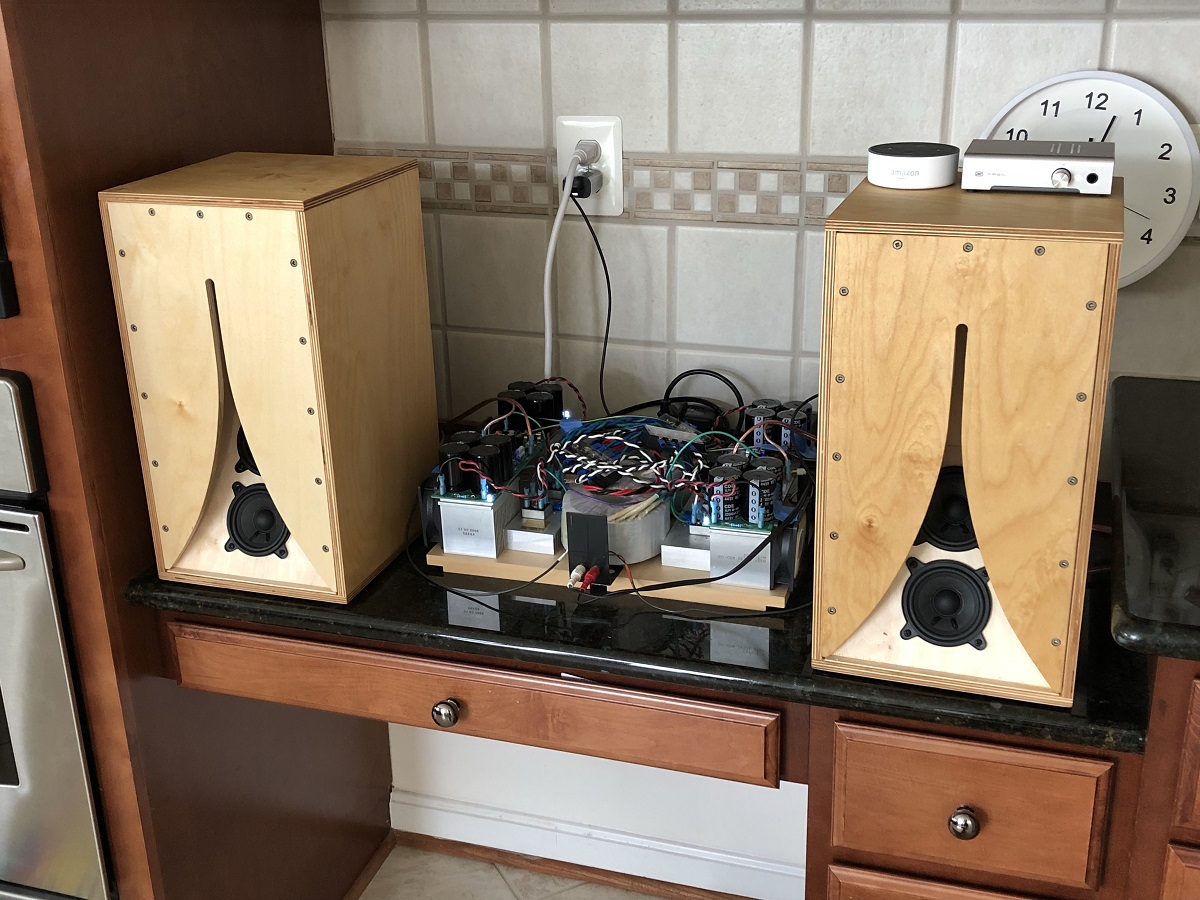
Try the Faital Pro 3FE25-16 lots of nice detail. I am running them in parallel in a Karlsonator and they sound very nice. I love headphones too.
https://www.diyaudio.com/forums/ful...onator-0-53x-dual-tc9fds-297.html#post5579020
Is the faital really that different from say tc9fd10...? Does the detail comes from better extended/boosted hi-freq. response or is it simply more revealing with reverb and stuff? the attractive 16 ohm spec should be easier on the amp, that is for sure.
i think it may be wiser to get a more «consensual» driver first like the one i just mentioned, if not just to have one to compare others too, to see if i get the «bite» and then «upgrade» toward something i like more. the tc9fd10, for instance, is readily available at store next to me. The fiberglass version also i can get for cheap from USA.
Maybe i could order one driver of each (faital+tc/tg9fd)...to be honest i listened to the clips in the tests with rounds you did and could't hear a lot of differences between the drivers, except for frequency response. The better quality clip i heard was the one in the early pages of the present thread («spanish harlem» song).
(If ever you are tired of discussing differences i would understand...anyway most are so cheap it's better to evaluate in person)
i think it may be wiser to get a more «consensual» driver first like the one i just mentioned, if not just to have one to compare others too, to see if i get the «bite» and then «upgrade» toward something i like more. the tc9fd10, for instance, is readily available at store next to me. The fiberglass version also i can get for cheap from USA.
Maybe i could order one driver of each (faital+tc/tg9fd)...to be honest i listened to the clips in the tests with rounds you did and could't hear a lot of differences between the drivers, except for frequency response. The better quality clip i heard was the one in the early pages of the present thread («spanish harlem» song).
(If ever you are tired of discussing differences i would understand...anyway most are so cheap it's better to evaluate in person)
Last edited:
If you look at the graph of the TC9FD and its cousins TG9/10F/etc they all fall off around 18kHz. The response curve for the 3FE25-8 actually goes past 20kHz. Where this helps is in the attack and transients rather than actually hearing notes above 20kHz. It does sound like it goes higher though.
If you look at the graph of the TC9FD and its cousins TG9/10F/etc they all fall off around 18kHz. The response curve for the 3FE25-8 actually goes past 20kHz. Where this helps is in the attack and transients rather than actually hearing notes above 20kHz. It does sound like it goes higher though.
Hi X can you take a new look at case or comment because cant ignore there looks to be something is off into this public statements translate how real objective data is interpreted to subjective statements, know below 3FE22-16 is not 100% exactly same as 3FE25-8 but it has nearly a same response into public factory datasheet as 3FE25-8 also cone/frame/dustcap/surround have semilarity.
Now at Faital Pro graph ratios we add 10F factory graph and also take TC9 verse 3FE22-16 from over at comparison thread offset below, these diameters is all into break up area and fall off but how is Faital stated to go past 20kHz if TC9 plus 10F is not.
At these ratios lets add a higher reach curve for TC9 from over ZAPP plus a smooth BW2 20kHz textbook target curve, looks its low cost TC9 that is overall winner if we talk smooth and high reach native out of box response.
It should be possible find out what one or another driver has the real world higest response reach even graphs are cut up there because of rate, zoom into small detailed numbers for IR at zero crossing line where the wider it goes there the slower it is relative to the other up higher.
Attachments
Hi Byrtt,
Thanks for showing the detailed comparisons. The Zaph extended data looks great, With you side by side comparisons, maybe the difference is not all that great - and I love the sound of the TC9FD, don't get me wrong as I have been using that from day 1 on 3 dozen projects. If we look at your detailed graphs, we can see that the 3FE22-16 has about 4dB more at 20kHz, and maybe it is also due to its higher sensitivity rated at 90dB at 1w/1m. It sounds qualitatively to have more top end to my ears. Albeit, not as smooth of a performer as the TC9FD overall.
Here is your data (which I think you are using 3FE22-16):
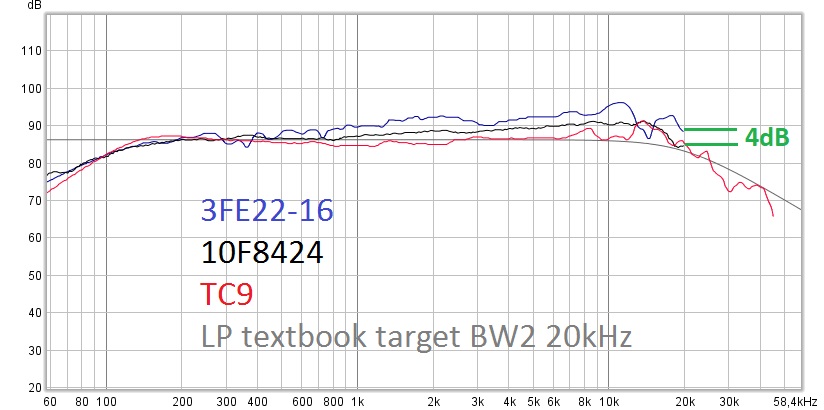
And here is 3FE25-16 (different motor and different T/S parameters with Qts of 0.82 so not really the same driver) - its response at 20kHz is even a bit higher, so maybe even +5dB more at 20kHz?:
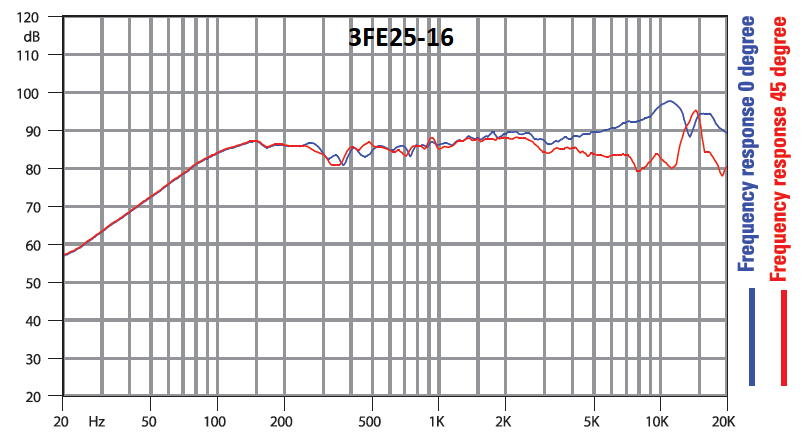
But these are all very minor differences. I can say that the 0.53x Karlsonator with dual TC9FD's sounds fantastic, from my memory.
Thanks for showing the detailed comparisons. The Zaph extended data looks great, With you side by side comparisons, maybe the difference is not all that great - and I love the sound of the TC9FD, don't get me wrong as I have been using that from day 1 on 3 dozen projects. If we look at your detailed graphs, we can see that the 3FE22-16 has about 4dB more at 20kHz, and maybe it is also due to its higher sensitivity rated at 90dB at 1w/1m. It sounds qualitatively to have more top end to my ears. Albeit, not as smooth of a performer as the TC9FD overall.
Here is your data (which I think you are using 3FE22-16):
And here is 3FE25-16 (different motor and different T/S parameters with Qts of 0.82 so not really the same driver) - its response at 20kHz is even a bit higher, so maybe even +5dB more at 20kHz?:
But these are all very minor differences. I can say that the 0.53x Karlsonator with dual TC9FD's sounds fantastic, from my memory.
Attachments
Last edited:
Hi X,
Thanks looking case again, think it points we should conclude if highest reach is supposed help in the attack and transients rather than actually hearing notes above 20kHz it should be heard better in a TC9 domain then, and if Faitals happen is sensed a higher reach it must be either their hotter rising response or peaks as frq goes up, included 3FE25-16 together 3FE22-16 from their datasheets and they close viewed into these ratio of axis numbers, below that look at 3FE22-16 from your own measurement setup from comparison thread where it falls off much steeper than TC9 indicating TC9 is not only the smoothest also its superior in highest reach that we see better into ZAPP graph in previous post.
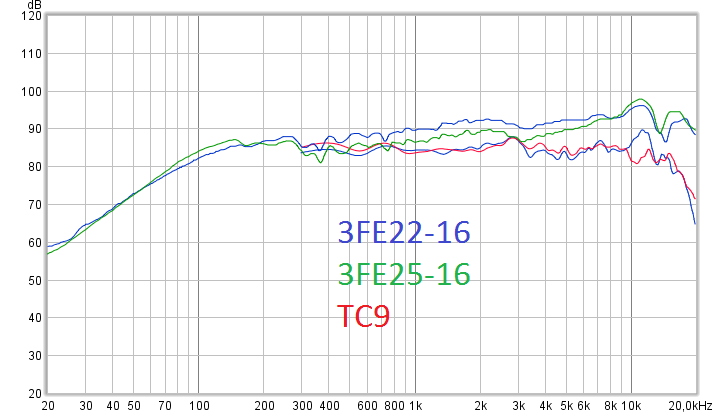
Thanks looking case again, think it points we should conclude if highest reach is supposed help in the attack and transients rather than actually hearing notes above 20kHz it should be heard better in a TC9 domain then, and if Faitals happen is sensed a higher reach it must be either their hotter rising response or peaks as frq goes up, included 3FE25-16 together 3FE22-16 from their datasheets and they close viewed into these ratio of axis numbers, below that look at 3FE22-16 from your own measurement setup from comparison thread where it falls off much steeper than TC9 indicating TC9 is not only the smoothest also its superior in highest reach that we see better into ZAPP graph in previous post.
Attachments
Last edited:
- Home
- Loudspeakers
- Full Range
- 10F/8424 & RS225-8 FAST / WAW Ref Monitor
